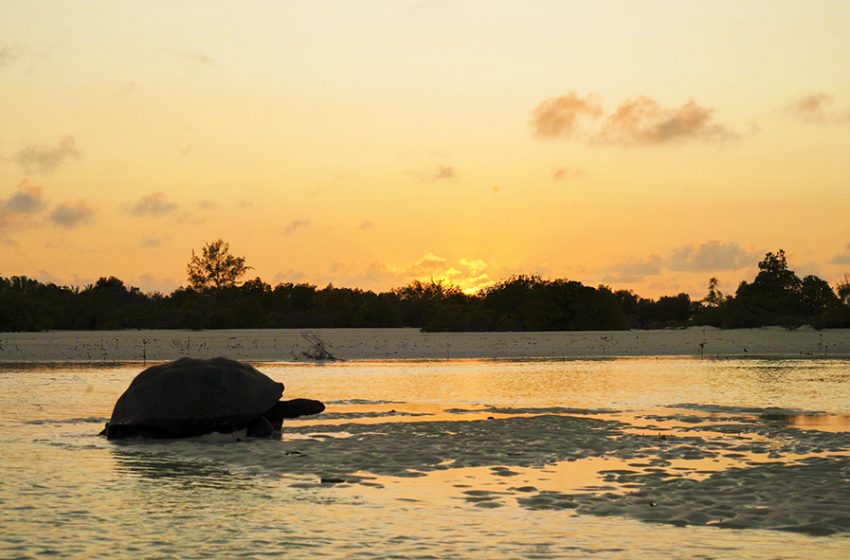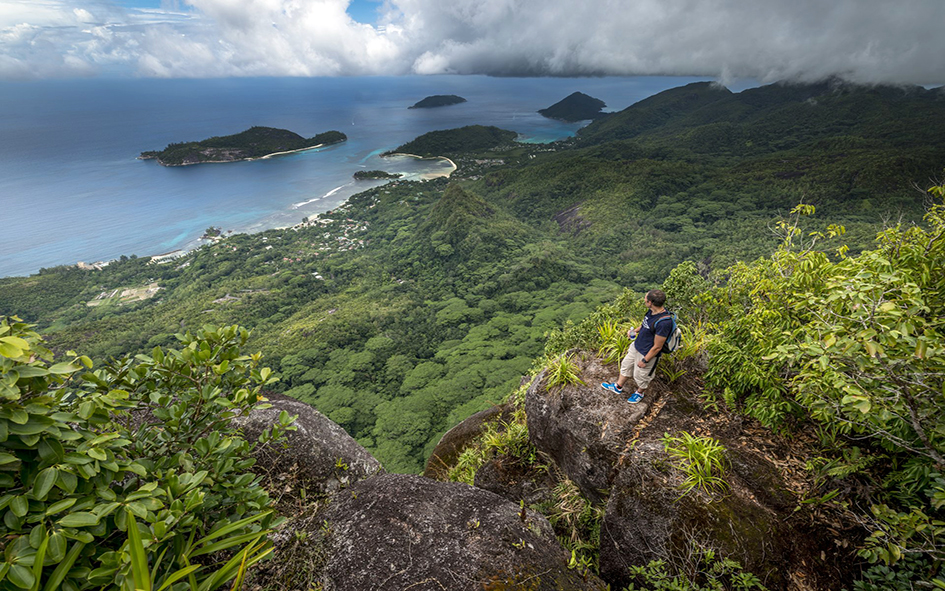The Stunning Flora & Fauna Of The Seychelles Islands

Discover The Seychelles Islands A World Within A World.
15 August 2022
Most travellers identify the Seychelles Islands with unsurpassed natural beauty and exoticism without being aware that these islands still, in many cases, slumbering in their first innocence since the dawn of Time, are home to staggering degrees of diversity and uniqueness when it comes to the species of flora and fauna to which they are home.
The islands of this sparkling archipelago, all but lost in the immensity of the western Indian Ocean, have been eloquently described as a chain of Noah’s Arks harbouring a treasure trove of natural treasures that have survived thanks to the islands’ remote location and also to their intrinsically benign nature, far from the cyclone belt and extremes of weather.
The first written accounts that come down to us from, for example, John Jourdain on his 1604 expedition under British captain Sharpeigh, describe the abundance and richness of nature on these islands they briefly visited by way of abundant timber, fowl, fish, coconuts, tortoises and even the crocodiles they came across in huge numbers, but which have since been hunted to extinction. Indeed, one of the earliest names bequeathed to Mahé, the main island, by the early French settlers was Isle of Abundance.
Still, today, this epithet is well-deserved because the still largely pristine state of many of its islands harbour many extraordinary species of flora and fauna found nowhere else except in these remote island sanctuaries.
There can be nothing so iconic of the Seychelles Islands than the wondrous coco-de-mer, Lodoicea maldivica, the world’s heaviest seed that falls from ancient, towering palms hiding in an ancient valley on the island of Praslin that is now a UNESCO World Heritage Site.
Long before its somewhat late discovery following the settlement of the islands in the mid-eighteenth century, the coco-de-mer nut intrigued the inhabitants of the various countries upon whose shores it washed up as the fruit of some mysterious tree growing beneath the waves.
The reputation of Seychelles’ amazing nut was further boosted by a visit of General Gordon of Khartoum, otherwise known as Chinese Gordon, who visited the islands on a military mission in 1881. Clearly fascinated by the suggestively-shaped nut, in a manuscript he depicted Praslin Island as the Garden of Eden and the coco-de-mer as the Tree of Knowledge.
Today, the 46-acre Vallée de Mai is an eloquent reminder of how Praslin must have looked in antiquity. Palms have been known to reach over 100 feet in height and the shade created by their giant, overlapping fronds still creates an ambiance of eternal twilight through which flit such visitors as the super-rare Seychelles Black Parrot, another endemic treasure of Seychelles. The Vallée de Mai is a not-to-be-missed treat on your adventures through the islands.

Besides the coco-de-mer, once prevalent on at least six islands but now very largely confined to Praslin, Seychelles’ flora contains over 1,000 species of plant of which about 250 occur naturally and 80 are endemic and found nowhere else on earth.
Endemic plants and animals are more prevalent on the granitic islands than elsewhere. This is because of the ancient geological history and greater altitude of these islands, which allows for higher rainfall and a diversity of habitats.
In sheltered river estuaries around the coasts grow mangrove trees, adapted to tolerate salty water and the low oxygen levels of estuary mud. Their amazing ‘breathing’ roots form a maze of archways and narrow pillars, amongst which crabs, young fish and a wide variety of other organisms thrive.
Many beaches are still fringed with native trees, bushes and creepers, such as takamaka Calophyllum inophyllum, bodanmyen Terminalia catappa, vouloutye Scaevola sericea and beach morning glory Ipomoea pes-caprae. These plants help to protect the coastline.
Further inland, the flat coastal ‘plateau’ is the previous site of coconut plantations that were once the mainstay of the islands’ economy. Originally covered with forest and freshwater marsh, much of this flat land is now given over to housing and agriculture. However, there is a wealth of introduced decorative bushes and flowers, such as frangipani, hibiscus and bougainvillea, adorning gardens and roadsides, and tropical fruit trees producing abundant and delicious mangoes, star fruit, golden apples and many others.
The mountain slopes which form the major part of the granitic islands are clothed with forest, which remains lush and green throughout the year. Although the forest has been much altered by human activities, the variety of endemic and indigenous plant species is high. Notable amongst these are trees such as bwa rouz, Dilennia ferruginea, with heavily ribbed leaves, bwa sagay (the Seychelles’ ebony), Diospyros seychellarum, shrubs such as kafe maron gran fey, Paragenipa wrightii, and herbs such as pti koko maron, Hypoxidia rhizophylla. Also to be found are introduced spice trees such as cinnamon, clove and nutmeg.
Very special vegetation occupies the large expanses of granite rock known as ‘glacis’. Conditions here are harsh and soil lies in small pockets between the rocks. Most plants have thick leathery leaves to reduce the loss of water. A rare sight is the ancient jellyfish tree, Medusagyne oppositifolia, whose brown parasol-shaped fruits resemble jellyfish and whose rediscovery in 1970 caused a sensation. Somewhat easier to see is the carnivorous pitcher plant Nepenthes pervillei, with little lidded pots at the ends of its leaves, in which insects are trapped, digested and absorbed, adding welcome nutrients to pitcher plant’s ‘diet’. Also easier to see is the Seychelles vanilla orchid, Vanilla phalaenopsis, with its thick leafless green stems and beautiful white flower.
Mist forest is found only above about 600 meters on the islands of Mahé and Silhouette. The mountain tops are frequently covered with cloud and humidity is high. Moisture-loving plants abound and trees are draped with mosses, ferns and tiny orchids. Pyramids of stilt roots support several vacoas, Pandanus spp., and one of the palms, Verschaffeltia splendida. Another typical tree is kapisen, Northea hornei, so-named because the large seed resembles the cowled head of a capuchin monk. The silent and eerie dankness of the forest is pierced only by the calls of endemic frogs, truly a special world of its own.
Although there is a range of walks available to hikers seeking a great introduction to these natural treasures of the islands, the ones below on Mahé are highly recommended. Excellent walks are also possible on Praslin and La Digue as well as on just about every island you might care to mention.

This 90-minute trail is a continuous climb from a high starting point in the Morne Seychellois National Park to the top of a prominent mountain of west Mahé, characterized by cloud forest but commanding extraordinary views. First passing through a tea plantation the trail encounters an interesting patch of endemic Vacoa plants as well as Capucin and Latanier. Higher up, one encounters Cinnamon forest, Jackfruit trees and Jambrosa. With altitude, the forest becomes moister, encouraging the growth of mosses and ferns which, together with sang dragon trees and bird nest ferns accompany the walker to the summit and to the spectacular views it offers. This trail offers the chance to see one of the tiniest frogs in the world as well as birdlife in the form of Seychelles’ Bulbuls, Mynahs and Sunbirds.
Copolia
This one-and-a-half-hour route, which commences at Val Riche, about 6km south from Victoria, offers stunning views from the summit of Copolia, accessed through Takamaka woodland, Cinnamon forest with Rubber trees featuring a variety of endemic palms and other endemic plants. Seychelles Bulbuls are common birds found here. Higher up, the proportion of endemic plants increases as the summit approaches with its glorious views of Morne Seychellois, Seychelle’s highest mountain, and Trios Frères. The panoramas of Mahé’s east coast, Praslin and La Digue are equally stunning.
Dans Gallas
This trail to a place once settled by Ethiopian people freed by the British Navy from Arab slavers takes two and a half hours to complete and commences at the information point at Le Niol before climbing to a shelter at its halfway point that offers amazing views of Beau Vallon Bay and Silhouette Island. Endemic palms make an appearance on the second half of the route as the path ascends into a Cinnamon forest dotted with Albezia and tall palms. The elusive Scops Owl can be found here.
Due to its extreme isolation, Seychelles has received more than its fair share of Nature’s bounty and today, with nearly half its limited landmass set aside as nature reserves, the ecological integrity of its islands remains intact – providing the visitor with some of the most unique ecological experiences to be found anywhere.








